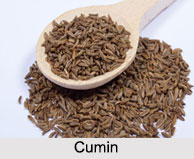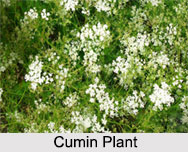 Cumin is a type of spice that forms an integral part of various dishes in the Indian cuisine. Cumin Seeds have an aromatic odour and a spicy and somewhat bitter taste. These are largely used as condiment and form an essential ingredient in all mixed spices and curry powders for flavouring soups, pickles, curries and for seasoning breads, cakes and so on.
Cumin is a type of spice that forms an integral part of various dishes in the Indian cuisine. Cumin Seeds have an aromatic odour and a spicy and somewhat bitter taste. These are largely used as condiment and form an essential ingredient in all mixed spices and curry powders for flavouring soups, pickles, curries and for seasoning breads, cakes and so on.
Etymology of Cumin
Cumin is known with various names all across the nation. The botanical name of Cumin is "Cuminum cyminum Linn" and belongs to the family "Apiaceae". Cumin is called "Jeera" in Hindi, "Jilakara" in Telugu, "Jeeragam" in Tamil, "Jeerakam" in Malayalam, "Jeerige" in Kannada, "Jeeru" in Gujarati, "Jeere" in Marathi and "Jeerey" in Bengali.
Origin of Cumin Seeds
 Cumin is believed to be the native of Egypt, Syria, Turkey and the Eastern Mediterranean region. In India, cumin is cultivated in almost all the states, but leading states are Uttar Pradesh, Punjab, Rajasthan, Gujarat and Tamil Nadu. It is said to be cultivated or occasionally found as a weed in Punjab, Himachal Pradesh, Assam and Bihar.
Cumin is believed to be the native of Egypt, Syria, Turkey and the Eastern Mediterranean region. In India, cumin is cultivated in almost all the states, but leading states are Uttar Pradesh, Punjab, Rajasthan, Gujarat and Tamil Nadu. It is said to be cultivated or occasionally found as a weed in Punjab, Himachal Pradesh, Assam and Bihar.
Properties of Cumin Seeds
Cumin is a good source of energy, vitamin A, C, E and B6, thiamine, riboflavin, niacin and vitamin, and minerals like iron, manganese, copper, calcium, magnesium, phosphorous and potassium. It is also rich in protein and amino acids, carbohydrates, dietary fibre and a reasonable amount of fats and fatty acids.
Use of Cumin Seeds in Cuisine
The most popular use for cumin is as a seasoning or condiment, adding a deep flavour to various recipes. This spice is a mainstay in curries, rice dishes like Biryani and Pulao and Indian vegetarian dishes like "Jeera Dal" and "Jeera Rice". Ideally, cumin seeds should be gently toasted or roasted before adding them to dishes.
Usage of Cumin Seeds in Medicine
Aqueous extract of cumin seed is frequently used for removing intestinal worms. The seeds have been considered as stimulant, carminative, stomachic, astringent and useful in diarrhoea and dyspepsia. Cumin is known for the benefits it offers, more than its taste or flavour, as it helps in losing weight, improving digestion and immunity, and treating skin disorders, boils, piles, insomnia and respiratory disorders.




















